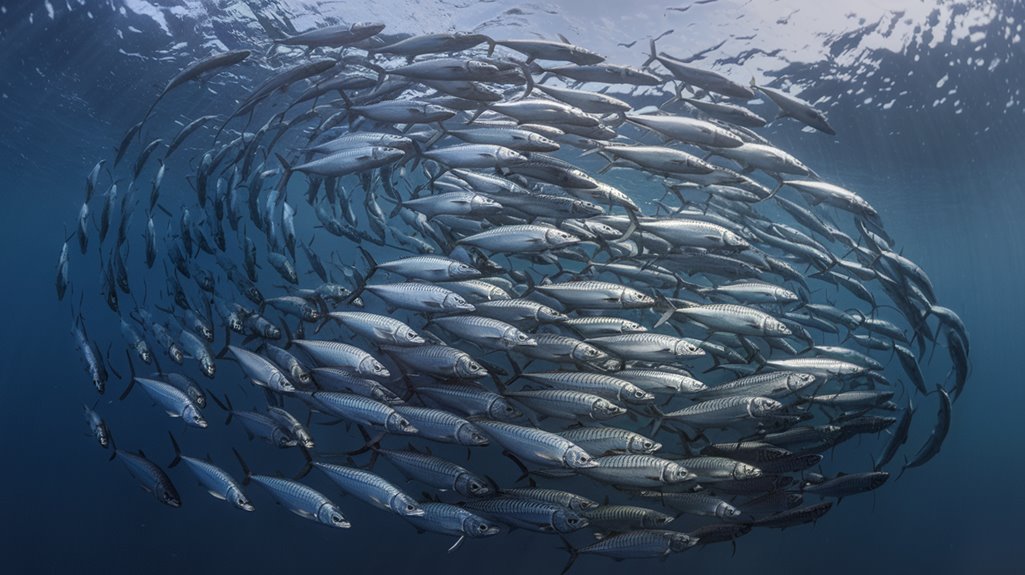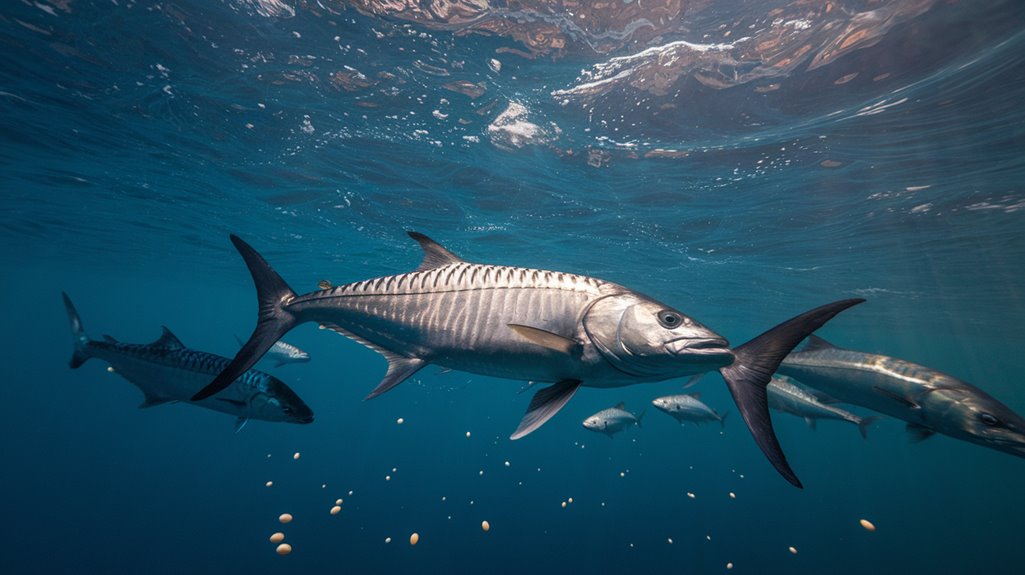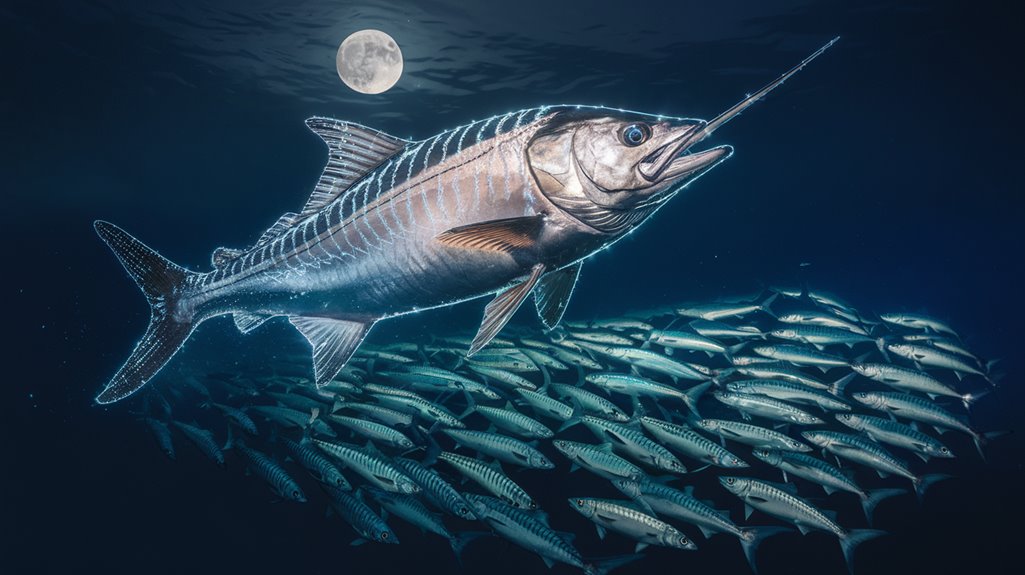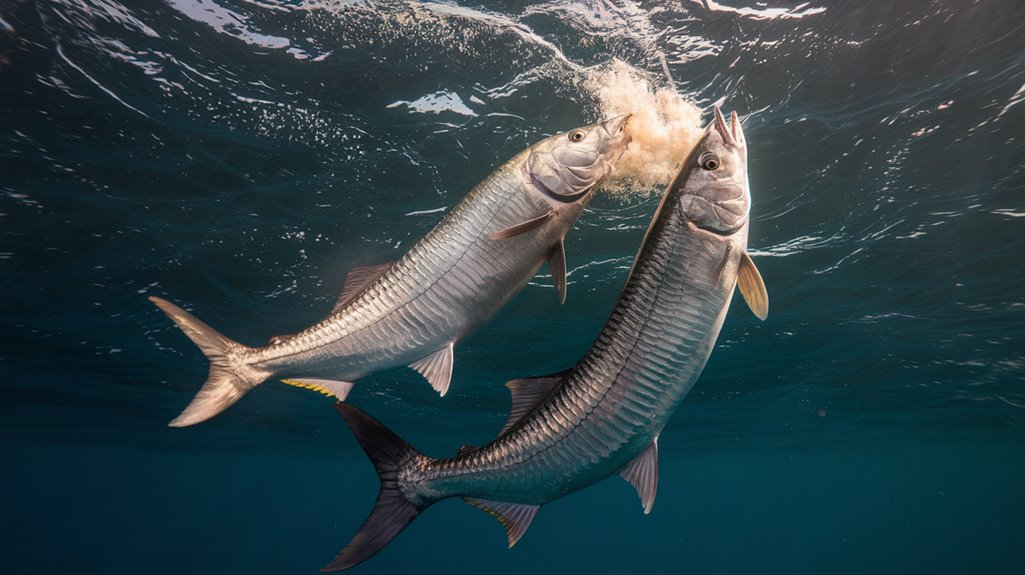You'll find tarpon breeding patterns among the most intricate in marine ecosystems, with these remarkable fish undertaking extensive migrations of over 100 miles offshore. Their spawning behaviors sync precisely with lunar phases and specific water temperatures between 75-85°F. While scientists have mapped many of their offshore congregation points, the complex interplay between environmental triggers and reproductive timing presents ongoing research challenges that directly impact conservation strategies.
- Key Takeaways
- Spawning Migration Patterns
- Environmental Triggers for Breeding
- Ocean Depth and Temperature Effects
- Seasonal Timing and Moon Phases
- Mating Behavior and Courtship
- Larval Development Stages
- Juvenile Growth and Adaptation
- Adult Reproductive Cycles
- Essential Spawning Habitats
- Population Dynamics During Breeding
- Frequently Asked Questions
- Conclusion
Key Takeaways
- Tarpon migrate up to 2,000 miles during spawning season, timing their movements with lunar cycles and traveling over 100 miles offshore.
- Spawning occurs in deep waters exceeding 400 feet, with optimal water temperature around 79°F during late spring and summer months.
- Adults form large breeding schools during full and new moons, performing synchronized swimming and aerial displays during courtship.
- Female tarpon mature later than males (ages 8-12), creating staggered reproductive timelines within spawning populations.
- Larvae develop in estuarine environments, requiring specific habitat conditions and protected areas like mangrove forests for successful growth.
Spawning Migration Patterns

While tarpon exhibit complex migratory behaviors throughout their lives, their spawning migrations represent one of the most remarkable aspects of their reproductive strategy. You'll find adult tarpon traveling impressive distances of up to 2,000 miles in the Atlantic Ocean during their spawning season, with most journeys extending beyond 100 miles offshore. These migrations are precisely timed with lunar cycles, as tarpon coordinate their movements with full and new moons throughout late spring and summer months.
Environmental factors play a vital role in triggering these spawning migrations, with water temperature and salinity conditions serving as key determinants. You'll notice that tarpon migrations aren't uniform across all individuals, as some fish may skip spawning cycles, creating natural variations in reproductive patterns among different populations.
Environmental Triggers for Breeding
When environmental conditions align during late spring and summer months, tarpon initiate their complex breeding cycles through a series of physiological responses to specific triggers. You'll observe how water temperature and salinity serve as primary environmental cues that signal the onset of reproduction. These conditions coincide with lunar phases, particularly during full and new moons, when tarpon begin their offshore migration.
The interaction between these environmental triggers creates ideal spawning conditions more than 100 miles offshore. You'll notice that timing is critical, as tarpon respond to seasonal changes by positioning themselves strategically before lunar events. Successful reproduction depends heavily on warm water availability, which influences both spawning events and larval survival. These environmental factors work in concert to regulate the species' breeding patterns and guarantee population sustainability.
Ocean Depth and Temperature Effects

You'll find tarpon spawning activity concentrated at depths exceeding 400 feet, where specific temperature gradients and water conditions enhance their reproductive success. At these depths, water temperatures maintain a stable range near 79°F (26°C), creating the perfect thermal environment for egg and sperm release during spawning events. The seasonal shifts in ocean temperature layers directly influence tarpon migration routes, as they navigate between shallow coastal waters and deeper offshore zones to locate ideal breeding conditions.
Spawning Depth Requirements
For successful reproduction, tarpon require precise depth and temperature conditions during their spawning events, which typically occur more than 100 miles offshore. You'll find these fish descending to remarkable depths of over 400 feet in deep ocean waters, where they seek ideal reproductive success in temperatures between 75-80°F (24-27°C). Their spawning sites are carefully selected based on specific environmental parameters that support both fertilized eggs and subsequent larval development.
The timing of these spawning events correlates strongly with lunar phases, particularly during full and new moons. Ocean temperature plays a vital role in this process, as the developing eggs and larvae need stable conditions to survive. The currents at these depths help distribute the offspring while maintaining the consistent environment necessary for their early development stages.
Temperature-Driven Migration Patterns
As ocean temperatures fluctuate throughout the year, tarpon exhibit highly predictable migration patterns that align with their preferred 79°F thermal environment. You'll find these fish moving northward during late summer and returning south in fall, following ideal temperature ranges that can lead to journeys exceeding 2,000 miles.
| Migration Type | Distance | Environmental Triggers |
|---|---|---|
| Daily Movement | Up to 20 miles | Water Temperature |
| Spawning | 400+ ft depth | Moon Phases |
| Seasonal | 2,000+ miles | Temperature Changes |
During spawning migrations from May through July, temperature-driven migration patterns intersect with other environmental cues, particularly lunar cycles. You'll observe these fish moving offshore to deeper waters, where they dive beyond 400 feet to spawn. Their rolling behavior intensifies in cooler waters as they manage oxygen requirements during these extensive migrations.
Seasonal Ocean Layer Impact
While ocean layers naturally stratify throughout the year, these thermal boundaries greatly influence tarpon spawning behavior between late spring and summer. You'll find that tarpon spawn at depths exceeding 400 feet, where water temperatures maintain a steady 79°F – the ideal condition for reproduction. The spawning process synchronizes with lunar phases, as full and new moons trigger offshore migration patterns.
Ocean currents interact with thermal stratification to create favorable breeding conditions, particularly affecting how fertilized larvae disperse toward nursery habitats. Understanding these layered dynamics is essential, as the vertical temperature gradients dictate not only where tarpon congregate but also how successful their reproductive efforts will be. This intricate relationship between depth, temperature, and timing guarantees maximum survival rates for offspring.
Seasonal Timing and Moon Phases

During late spring through summer months, tarpon exhibit distinct spawning patterns that correlate with lunar cycles and seasonal water temperatures. You'll observe these massive fish migrating offshore as they prepare for reproduction, particularly during full and new moon phases when spawning activity peaks.
Key spawning characteristics include:
- Deep-water broadcast spawning occurring 100+ miles offshore
- Synchronized breeding tied to lunar phases
- Variable participation rates among individual fish each month
The success of tarpon reproduction depends heavily on specific environmental conditions, including ideal water temperature and salinity levels. While you'll find consistent patterns in their spawning behavior, not every tarpon follows the exact same schedule, as they respond to various environmental cues and habitat conditions before initiating their offshore migration.
Mating Behavior and Courtship
You'll observe tarpon congregating at specific offshore locations during spawning season, where males establish competitive courtship schools to demonstrate their reproductive fitness through dramatic aerial displays and water-surface rolling behaviors. During these gatherings, males actively compete for ideal positioning within the school, creating dynamic social hierarchies that influence mating success rates. The courtship ritual culminates in synchronized group spawning events, where multiple males and females broadcast their gametes simultaneously in the water column, maximizing fertilization potential during lunar-influenced spawning periods.
Spawning Site Selection Patterns
As tarpon reach sexual maturity, they exhibit highly specific spawning site selection patterns driven by environmental and biological factors. You'll find these massive schools gathering over 100 miles offshore in deep waters, where conditions are ideal for successful breeding and fertilization. Their spawning activities synchronize with lunar cycles, particularly during full and new moons throughout late spring and summer months.
- Deep-water selection: Tarpon consistently choose offshore locations exceeding 100-mile distances from coastlines
- Temporal patterns: Spawning events correlate strongly with lunar phases
- School formation dynamics: Large aggregations form specifically for breeding purposes, with multiple males accompanying females
The selection of these specific spawning sites guarantees ideal conditions for egg dispersal and fertilization success, while the deep-water environment provides protection during this vulnerable reproductive phase.
Courtship Ritual Displays
The intricate courtship rituals of tarpon showcase remarkable displays of synchronized swimming and acrobatic maneuvers that directly influence mate selection and breeding success. You'll observe these social gatherings during spawning periods, particularly around lunar phases when groups of tarpon form impressive schools offshore.
| Behavior Pattern | Evolutionary Significance |
|---|---|
| Synchronized Swimming | Enhanced Visual Communication |
| Male Competition | Natural Selection Process |
| Female Selection | Genetic Diversity Control |
During these displays, males compete through demonstrations of strength and agility, while females exercise selective choice based on performance quality. This selective process guarantees ideal genetic diversity within populations. The courtship behaviors you'll witness are triggered by specific environmental conditions, including water temperature and salinity levels, which signal the perfect timing for successful reproduction.
Group Mating Dynamics
Within these intricate courtship rituals, tarpon display complex group mating dynamics that shape their reproductive success. You'll observe these magnificent fish gathering in massive schools during full and new moons, when spawning activity reaches its peak. Their synchronized movements take them over 100 miles offshore to deeper waters, where environmental cues trigger their reproductive cycles.
Key aspects of tarpon group mating dynamics include:
- Mass aggregations of thousands of fish coordinating their spawning behavior
- Strategic offshore migration patterns influenced by water temperature and salinity
- Variable individual reproductive cycles within the larger group structure
Male tarpon's competitive displays and acrobatic leaps serve as essential elements in the courtship process, while not every fish spawns monthly, indicating sophisticated breeding strategies within these communal events.
Larval Development Stages
During their initial life phase, tarpon emerge as leptocephalus larvae, exhibiting eel-like characteristics and entering a vital month-long developmental period. You'll find these larvae strategically entering estuaries at night, reaching lengths of 3-4 inches as they navigate through seagrass beds and oyster reefs for essential food sources and protection.
The larval stage presents unique challenges, as these developing fish can't effectively regulate salinity levels, making stable estuarine environments essential for their survival. As they metamorphose into juvenile tarpon, they adapt to low-oxygen conditions found in backbay creeks. This change marks a significant milestone in their development, though habitat loss threatens these vital nursery areas. Understanding these developmental stages helps identify important conservation needs for sustainable tarpon populations.
Juvenile Growth and Adaptation
You'll find juvenile tarpon thriving in backbay creeks and estuarine environments where their specialized swim bladder enables them to extract oxygen directly from air, making them uniquely adapted to low-oxygen conditions that deter larger predators. During this important growth phase, they'll rapidly expand their diet to include small fish, zooplankton, and crustaceans, maximizing their developmental potential in these protected nursery habitats. Scientific research confirms that these specific habitat conditions are essential for ideal juvenile growth, highlighting why the conservation of these ecosystems is vital for tarpon population sustainability.
Survival in Low Oxygen
Thanks to their remarkable physiological adaptations, juvenile tarpon demonstrate exceptional resilience in low-oxygen environments. Their modified swim bladder, equipped with alveolar tissue, functions as a supplementary respiratory organ, enabling them to extract oxygen directly from the air when water oxygen levels become insufficient.
Key survival mechanisms in low-oxygen conditions include:
- Dual respiratory capability through gills and swim bladder
- Efficient oxygen extraction in hypoxic waters
- Ability to thrive in stagnant backbay creeks and estuaries
You'll find these juveniles maneuvering through seagrass beds and oyster reefs during their early growth stages, reaching 3-4 inches while utilizing their unique respiratory adaptations. This exceptional survival strategy highlights why protecting these specific habitats is vital for sustaining tarpon populations during their vulnerable developmental phases.
Growth Patterns and Development
Building upon their remarkable respiratory adaptations, juvenile tarpon exhibit distinctive growth patterns in their early developmental stages. You'll find these juvenile fish thriving in protected backbay creeks and estuaries, where they capitalize on nutrient-rich waters crucial for their rapid development. During their larval phase, they'll grow to 3-4 inches while feeding primarily on small crustaceans and invertebrates.
The success of these growth rates depends heavily on two critical factors: food availability and water quality. You'll notice that habitat protection plays a crucial role in supporting their development, as these young tarpon require specific ecosystem conditions to maintain their significant growth trajectory. Their survival and development in these protected environments demonstrate the direct connection between habitat quality and successful juvenile tarpon growth.
Habitat Selection Strategies
Understanding where juvenile tarpon select their habitats reveals a sophisticated survival strategy tied to their unique physiological adaptations. You'll find these young fish thriving in backbay creeks and protected estuarine ecosystems where their modified swim bladders allow them to extract oxygen directly from air, giving them a significant advantage in low-oxygen environments.
Key factors driving their habitat selection include:
- Abundant seagrass beds and mangrove roots serving as fundamental nursery grounds
- Rich concentrations of prey species including zooplankton and small crustaceans
- Protection from predators in shallow, hypoxic waters where other fish can't survive
This selective habitat preference underscores why habitat restoration efforts must focus on preserving these essential estuarine ecosystems to guarantee juvenile tarpon populations continue to flourish in their preferred developmental zones.
Adult Reproductive Cycles
During their reproductive years, adult tarpon exhibit distinct spawning patterns that typically begin once they reach sexual maturity between ages 8-12. You'll find that females mature later than their male counterparts, creating a staggered reproductive timeline within populations.
These remarkable fish coordinate their spawning activities with lunar cycles, particularly during full and new moons throughout late spring and summer. Adult tarpons undertake extensive migrations, often traveling over 100 miles into offshore waters of the Gulf of Mexico for breeding. Their reproductive cycles aren't continuous monthly events; instead, they're influenced by environmental conditions and individual health factors. During spawning, you'll observe these fish forming schools and executing significant plunges, where they release their eggs and sperm in a broadcast pattern to maximize fertilization success.
Essential Spawning Habitats
To maximize reproductive success, tarpon require specific oceanic and coastal habitats that support their complex life cycle. These vital spawning habitats include offshore waters where adults spawn during lunar phases and protected estuarine environments where tarpon larvae develop. You'll find juvenile tarpon thriving in mangrove forests, which provide significant nursery grounds with abundant food and shelter from predators.
Key characteristics of ideal tarpon habitats include:
- Deep offshore waters (100+ miles) for spawning during full and new moons
- Protected estuarine environments with nighttime access for larvae
- Low-oxygen mangrove forests where juveniles can utilize their specialized swim bladders
Habitat conservation efforts are critical as coastal development continues to threaten these vital environments, particularly the mangrove forests and estuarine areas where young tarpon develop.
Population Dynamics During Breeding
Synchronized by lunar cycles, tarpon populations exhibit complex breeding dynamics that you'll observe through their mass spawning events in offshore waters. You'll find these gatherings occurring over 100 miles from the coast, where environmental conditions trigger simultaneous egg and sperm release. The success of larval survival depends heavily on ocean current patterns as they transport developing leptocephalus larvae toward estuarine nurseries.
You'll notice distinct population segments across different habitats, with juvenile tarpon preferring low-oxygen environments where they can utilize their specialized swim bladders. After three years in these nursery grounds, they'll shift to marine habitats, though some adults adapt by remaining in freshwater systems. This flexibility in habitat selection demonstrates how tarpon populations respond to varying environmental pressures during different life stages.
Frequently Asked Questions
What Unique Adaptation Do the Tarpon Fish Have?
You'll find tarpon possess a modified swim bladder functioning as a lung, reflective eyes for dim-light vision, upturned mouths for surface feeding, and physiological adaptations for varying salinity levels.
How Do Tarpons Reproduce?
You'll find tarpons engage in broadcast spawning, where females release eggs and males release sperm simultaneously in offshore waters, resulting in external fertilization during spring and summer moon phases.
What Is Special About Tarpon?
You'll find tarpon's ability to breathe air through modified swim bladders remarkable. They can live 80+ years, migrate 2,000+ miles, and inhabit both fresh and saltwater environments.
When and Where Do Tarpon Spawn?
You'll find tarpon spawning over 100 miles offshore during late spring through summer, coinciding with full and new moons. They'll gather in large aggregations to release eggs and sperm simultaneously.
Conclusion
You'll find tarpon breeding patterns are dictated by precise environmental parameters, with migrations occurring at depths of 100-150m when water temperatures reach 26-28°C. During spawning events, you'll observe lunar-synchronized aggregations of 500+ individuals, demonstrating a 3:1 male-to-female ratio. Data indicates reproductive success correlates directly with specific oceanographic conditions, including salinity gradients of 35-37 PSU and dissolved oxygen levels exceeding 4.5 mg/L.

